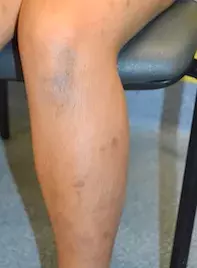What’s the diagnosis?
A pruritic rash on the lower legs and arms



Case presentation
A 10-year-old girl presents with a six-month history of an intensely pruritic rash mainly over the extensor surfaces of her lower legs and arms. She is otherwise well. Six years previously she had been referred to a dermatologist for management of atopic dermatitis, and then discharged to the care of her GP.
On examination, erythematous, excoriated nodules are observed bilaterally over her lower legs, knees, forearms and the dorsal surface of her fingers (Figures 1a and b). Several of the nodules over her knees are ulcerated.
No other members of her family have a skin problem.
Differential diagnoses
Conditions to consider among the differential diagnoses for a child of this age include the following.
- Hypertrophic lichen planus. This T-cell mediated autoimmune disease affects the skin and/or mucosal surfaces. Violaceous plaques and papules appear most commonly over the ankles, lower back and wrists. The lesions are usually intensely itchy. This condition is very rare in children and is most commonly seen in women over 40 years of age.
- Scabetic nodules. This very contagious condition causes intense, generalised itching as a result of hypersensitivity to the Sarcoptes scabiei mite. The itch develops four to six weeks after transmission. The rash is characterised by papules and nodules, particularly on the genital area and nipple, vesicles and burrows on the palms, soles and web spaces, and widespread linear excoriations. The condition will be especially suspected if other members of the household report itch. Diagnosis is confirmed by visualisation of the mite or its products on microscopy of a skin scraping. On dermoscopy, a mite at the end of a burrow has a characteristic ‘hang-glider’ appearance. A diagnosis of scabies necessitates high levels of suspicion in children presenting with itch.
- Persistent insect bite reactions. Papular urticaria is an allergy to insect bites and is most common in children aged 2 to 10 years. The most commonly implicated insects are mosquitoes and fleas. Pruritic erythematous patches or nodules appear on exposed areas, particularly the arms and legs, and can last several weeks. The lesions are intensely itchy and usually excoriated and superinfected. The reaction is most commonly seen in the summer and autumn months due to the seasonal nature of insects. The nodules may be ulcerated if they have been scratched.
- Molluscum contagiosum. This very common viral skin infection in children typically appears as widespread waxy flesh-coloured papules with a central pit (umbilicated) from which a viral particle can be expressed. Occasionally the papules may be associated with secondary dermatitis, particularly in atopic individuals, which may then become itchy and erythematous, especially if secondary infection occurs after scratching. The rash is self-resolving as children grow and is not associated with intense itch.
- Prurigo nodularis. This is the correct diagnosis. Prurigo nodularis is characterised by nodules that are the result of repetitive scratching or picking of skin over an extended period. Multiple nodules are present on extensor surfaces where the individual can easily reach them and they can be erythematous or hyperpigmented (Figure 2). Prurigo nodularis is primarily a disease of adults; however, it also occurs in children, who usually have a pre-existing itchy skin or systemic condition associated with pruritus (commonly atopic dermatitis or psoriasis). The repetitive scratching may sometimes be a result of an underlying psychological condition such as anxiety or obsessive compulsive disorder. Persistent scratching of the lesions leads to a scratch–itch cycle that is difficult to manage.
Investigations
Prurigo is usually a clinical diagnosis in children. The choice of investigations required will depend on the individual patient. In adults, there are many conditions associated with generalised pruritus that should be excluded, including biliary cirrhosis, end-stage renal disease and polycythaemia vera. A skin biopsy may be appropriate if the provisional diagnosis is not clear or if the condition is refractory to treatment.
Management
Treatment of prurigo can be difficult. The first step is focused on preventing ongoing skin picking and scratching. Potent topical corticosteroid ointments such as betamethasone dipropionate used under wet dressings, particularly overnight, are first-line treatments to manage the pruritic nodules. For nodules that remain refractory to treatment, UV therapy or calcineurin inhibitor (tacrolimus ointment [compounded medication, off-label use in Australia] or pimecrolimus cream) may be considered. It is also important in prurigo to manage the underlying cutaneous or systemic disease. In children with eczema and psoriasis, this can sometimes involve the use of oral immunosuppressive agents. In the case of psychological conditions, referral to a psychologist or psychiatrist may be appropriate.
For the patient described above, the itch was suppressed successfully with twice-daily betamethasone dipropionate ointment, nightly wet dressings and an antihistamine as a night sedative. The nodules flattened within one month but areas of hyperpigmentation remained for almost 12 months.

